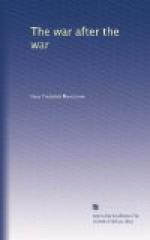This evidence of debt is not the kind of foreign investment suitable for the man or woman with savings to employ because it is more or less a banking transaction. These credits usually net about 61/2 per cent.
With the exception of a comparatively small amount of German and Austrian Bonds bought in the main by natives of these two countries for purely sentimental and patriotic reasons, the entire bulk of European loans placed in America is for the Allied countries, principally England and France who are our heaviest customers in trade.
The largest foreign loan brought out here so far is the Anglo-French 5 per cent External Loan which was negotiated through J. P. Morgan & Company—Fiscal Agents for the Allies over here—by the Commission headed by Lord Reading and Sir Edward Holden. It is the Joint and Several Obligation of the Governments of the United Kingdom of Great Britain and Ireland and the French Republic, is dated October 15, 1915, and is due five years after that date. It ranks first amongst the foreign war obligations of these countries.
This was the first big credit arranged by England or France in the United States and the proceeds were used, in the manner that I have already described, for the purchase of American goods and to stabilize the foreign exchange. These bonds which have had a very wide sale in America were brought out at 98 and interest and at the time of issue represented an investment that paid nearly 51/2 per cent.
These bonds, I might add, are convertible at the option of the holder on any date not later than April 15, 1920, or provided that notice is given not later than this date, par for par, into 15-25 Year Joint and Several 41/2 per cent bonds of the Governments of the United Kingdom of Great Britain and Ireland and the French Republic. Such 41/2 per cent bonds, payable, principal and interest, in United States gold coin, in New York City, and free from deduction for any present or future British or French taxes, will mature October 15, 1940, but will be redeemable, at par and accrued interest, in whole or in part, on any interest date not earlier than October 15, 1930, upon three months’ notice.
The equity behind these bonds is the good name, wealth and taxing power of the issuing countries. The interest on this loan equals only one-fifth of one per cent of the total estimated income of the British people in 1914. It is slightly more than one-third of one per cent of the French Republic in 1914.
Between this loan and the next large borrowing by England or France in the United States occurred an event of significance to the American investor interested in the securities of foreign nations. The Anglo-French loan, as you know, was simply the promise to pay of two great countries whose Government Bonds at home represented the last word in unshakable security.
But when England and France stepped up to our money counters again, Uncle Sam put sentiment aside and became a pawn broker. “I think you are all right,” he said, “but you are in a war that may last a very long time and I must have collateral.”




